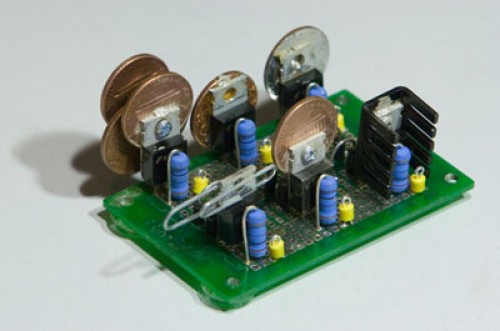Next time you are building a project and find a component running a bit hot you may want to look in your pocket for a few pennies to solve the problem. This Penny Heatsink idea is a nice idea since I can think of a number of times that I have bolted on expensive heatsinks when I only needed a bit of heat dissipation but a large heat sink is all I had on hand. The author suggests that it’s not really worth the effort and a good heatsink should be used but this is not always practical so I think it’s worth a try. 🙂
"In a recent thread on Head-Fi, someone asked how well a paperclip would work for heat-sinking a TO-220 part. Much speculation ensued (much of it from your humble author), including opinions that a penny might work better, and then the argument moved on to exactly how to use the penny and so on. I eventually decided that experimentation was called for, which lead to this article."


Permalink
Thats just stupid.. And illegal in some contries. Rather take a small piece af scrap metal, drill a hole, bend it and snap it on.
Permalink
Might be best to use pre-1982 American pennies, since those are pure Copper, while post-1982 American pennies are Copper clad Zinc (Copper has a higher thermal conductivity than Zinc.) (excluding 1943, of course).
http://en.wikipedia.org/wiki/Cent_(United_States_coin)
Dave
Permalink
Interesting Dave, I guess all pennies are definitely not created equal. Let me guess, you are a coin collector?
Permalink
You could run the penny through on of those roller machines you find at various tourist venues to produce more surface area. Or a nearby active rail line could work.
Permalink
Permalink
Permalink
Permalink
Permalink
i prefer using aluminium finned heatsinks and a bit of thermal grease
Permalink
Illegal!!!!! Destruction of GOVERNMENT PROPERTY!!!! IM TELLING!!!
Permalink
Hi Ethan,
I don’t think this is illegal in any country (at least not in Canada or the US). For example those souvenir penny squishes are legal even though the coin is not usable after it is done.
Permalink
Permalink
its only illegal if the intent is fraudulent… burning money to cover something up…
If its not fraudulently done, its not illegal.
Permalink
Permalink
I was lucky to obtain a bunch of small heatsinks from an old EE friend, but creative approaches to solving simple problems like this are always welcome. I’m sure at some point I’ll be somewhere without a heatsink on hand, and this little tip will come in handy.
Permalink
Sorry, have to post again. Interesting test results. I was actually surprised at how well the paperclip did. Works pretty well in a pinch. By the way, what software did you use to detail and graph the test results in the provided PDF? The file looks very professional.
Permalink
Hi Jack,
Actually it was just featured here, the site that you went to to see the graphs is the creators site. I also found it interesting how much a paperclip can do. I have often used an alligator clip when testing a circuit before installing the heatsink and am always impressed by how a simple metal clip can wick away heat so effectively.
Permalink
Permalink
The fact that he was able to solder the penny already indicates it is not such a good heatsink …
I’ve had relatively good results using paper clamps (only as a temporary measure, of course).
Permalink
This is illegal in the England (using English pennies atleast), no matter what the intent, defacing the Queens head is punishable as treason in England which leads me to my next point, anyone thing swans would make a good heatsink? 🙂
Permalink
The newer pennies here in the UK are easily identifiable as not being pure copper because you can pick them up with a magnet.
I wonder how well a 2 pence piece would fair as a heatsink…
vic, looks like a couple of pennies were bolted on – perhaps testing different methods of attachment?
Permalink
Permalink
Permalink
I’m not going to lie, i know nothing about heat sinks
But what about using the souvenier pennies that are flattened?
more surface area right? same conductivity?
Permalink